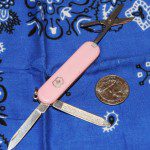by Leon Pantenburg While I wouldn't recommend a Swiss Army knife as the only choice for a survival knife, there are sound reasons for including one in your short list of survival tools.
Convenience: If a survival tool is convenient and easy to carry, it will get taken along. The best survival tool in the world is useless unless it's available when needed.
 |
| The Classic |
Low Price: You can spend a lot on a Swiss Army knife, but IMO, you'll end up with a bunch of unnecessary options. Decide what your knife needs are, and you can find the correct combination.
Quality: For a reasonably-priced knife, the Swiss Army has good stainless steel blades, and well-made hinges. Chances are you'll never wear one out. If you do, the knife has a lifetime guarantee, and you'll get a no-questions-asked replacement.
Classic: This is the smallest model, and it fits on a keychain very nicely. I was given my first Classic as a performance award at the company I worked for, and initially wondered what good it would be. Later, I wondered how I ever got along without it. (To read my review of the Classic, click here.)
The Classic has the one-and-one-half inch blade that is adequate for most everyday tasks, such as cutting string or opening mail. This lets you save your other, bigger blades for more important work. The tweezers are excellent, and the nail file will be used more than you can imagine. I usually grind the tip of the nail file to fit my glasses hinge screw, which gives you another incredibly useful tool. All my survival kits include a Classic.
Tinker: A Tinker and a Classic are part of my wardrobe. Unless I'm going to a courtroom or some other restricted area, I have this duo with me. My current Tinker was given to me by the late Jim Grenfell, who carried my particular knife for years. The slim, two-layer width makes it comfortable to carry in a pocket. My son also carries a Tinker every day. The basic Tinker generally retails for under $20, and is an incredibly useful combination, with everything you'll typically need and nothing you don't. (Here is a great deal on a Tinker/Classic combo.)
 |
| The Hunter |
In several instances, the pliers were used to remove hooks from sharp toothed fish. The scissors is also useful for such things as cutting moleskin or duct tape, and this model is a good choice for a backpacker. What I don't like about the Deluxe Tinker the four-layer width, which makes it somewhat bulky. It is not comfortable to carry in a pocket (for me), so mine generally rides in a belt pouch. This is a great all-around knife for most outdoor activities.
Hunter: My wife bought the first Hunter model in the family prior to a canoe trip in the Boundary Waters. Except for the corkscrew, I like the knife very much. It has a large, 3-1/4- inch locking drop point blade, which makes it a viable tool for field dressing big game animals. It also has a superb saw, which is quite capable of cutting through a whitetail deer pelvis or femur.
Several years ago, I flew to Mississippi for a deer/small game hunt. Since baggage space was limited, I took my Cold Steel SRK for deer, and the Swiss Army Huntsman for small game. Both did their jobs very well. My only change would be to replace the corkscrew with a Phillips head screwdriver. My wife, on the other hand, has a somewhat different philosophy about outdoor camping and cuisine and would never give up her corkscrew!
Workchamp: I have never owned one of these, and questioned the need for owning something with all those do-dads. But that was before I interviewed a member of the Idaho National Guard after his deployment to Desert Storm in 1990. The soldier's brother handed him a Workchamp as he was boarding the plane for Kuwait.
The soldier attached the knife to a lanyard on his belt, and his whole squad used it constantly for a multitude of tasks. The pliers were in great demand, according to the guardsman, for removing cans of boiling water from their tiny backpacking stove.
The Workchamp showed some wear, but the lanyard and belt pouch kept it from getting lost or disappearing. Most, if not all, of the tools were used regularly, the soldier told me, because they were moving constantly, and didn't have the room or space to carry much else beside food, weapons and water. Today, that knife is undoubtedly a cherished family heirloom.
That is what most people find out about their Swiss Army knives. It is quite possible to bond with your Swiss Army knife, especially after a history of faithful service.
That's what I find with my Tinker. Jim Grenfell used it for years, it was passed on to me, and unless I lose it, that knife will be passed on again. Until then, I'm sure Jim's Tinker will continue to serve me well!
No comments:
Post a Comment